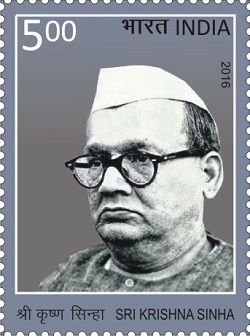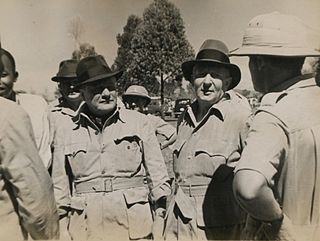
Bihar is a state in eastern India. It is the third largest state by population, the 12th largest by area, and the 14th largest by GDP in 2021. Bihar borders Uttar Pradesh to its west, Nepal to the north, the northern part of West Bengal to the east, and Jharkhand to the south. The Bihar plain is split by the river Ganges, which flows from west to east.

The Bihar School of Yoga is a modern school of yoga founded and developed by Sri Swami Satyananda Saraswati in Munger, Bihar, India, in 1963. The system of yoga taught at the Bihar School of Yoga is recognized worldwide as Bihar Yoga or the Satyananda Yoga tradition. In 2019, the Bihar School of Yoga was awarded the Prime Minister’s Award for Outstanding Contribution Towards Promotion and Development of Yoga.

Arrah is a city and a municipal corporation in Bhojpur district in the Indian state of Bihar. It is the headquarters of Bhojpur district, located near the confluence of the Ganges and Sone rivers, some 24 mi (39 km) from Danapur and 36 mi (58 km) from Patna.

Shri Krishna Singh (Sinha) (21 October 1887 – 31 January 1961), also known as Shri Babu, was the first chief minister of the Indian state of Bihar (1946–61). Except for the period of World War II, Sinha was the chief minister of Bihar from the time of the first Congress Ministry in 1937 until his death in 1961. Along with the Desh Ratna Rajendra Prasad and Bihar Vibhuti Anugrah Narayan Sinha (A.N. Sinha), Sinha is regarded among the 'Architects of Modern Bihar'. He also led the Dalit entry into the Baidyanath Dham temple (Vaidyanath Temple, Deoghar), which reflected his commitment towards the upliftment and social empowerment of the Dalits. He was the first chief minister in the country to abolish the zamindari system. He underwent different terms of imprisonment for a total of about eight years in British India. Sinha's mass meetings brought hordes of people to hear him. He was known as Bihar Kesari for his lionlike roars when he rose to address the masses. His close friend and eminent Gandhian Bihar Vibhuti A.N. Sinha in his essay Mere Shri Babu wrote that, "Since 1921, the History of Bihar has been the history of the life of Shri Babu".

Nitish Kumar is an Indian politician, who is serving as 22nd Chief Minister of Bihar since 22 February 2015, having previously held the office from 2005 to 2014 and for a short period in 2000. He is Bihar's longest serving chief minister. He is the leader of the Janata Dal (United). Previously, Kumar also served as a Union Minister as the Samata Party member. He was member of the Samata Party until 2005 and Janata Dal from 1989 to 1994. Kumar first entered politics as a member of the Janata Dal, becoming an MLA in 1985. A socialist, Kumar founded the Samata Party in 1994 along with George Fernandes. In 1996 he was elected to the Lok Sabha, and served as a Union Minister in the government of Atal Bihari Vajpayee, with his party joining the National Democratic Alliance. In 2003 his party merged into the Janata Dal (United), and Kumar became its leader. In 2005, the NDA won a majority in the Bihar Legislative Assembly, and Kumar became chief minister heading a coalition with the Bharatiya Janata Party.

The provinces of India, earlier presidencies of British India and still earlier, presidency towns, were the administrative divisions of British governance on the Indian subcontinent. Collectively, they have been called British India. In one form or another, they existed between 1612 and 1947, conventionally divided into three historical periods:
Bihari is a demonym given to the inhabitants of the Indian state of Bihar. Bihari people can be separated into three main Indo-Aryan ethnolinguistic groups, Bhojpuris, Maithils and Magadhis. They are also further divided into a variety of hereditary caste groups. In Bihar today, the Bihari identity is seen as secondary to caste/clan, linguistic and religious identity but nonetheless is a subset of the larger Indian identity. Biharis can be found throughout India, and in the neighbouring countries of Nepal, Pakistan and Bangladesh. During the Partition of India in 1947, many Bihari Muslims migrated to East Bengal. Bihari people are also well represented in the Muhajir people of Pakistan because of Partition.

Bihar and Orissa was a province of British India, which included the present-day Indian states of Bihar, Jharkhand, and Odisha. The territories were conquered by the British in the 18th and 19th centuries, and were governed by the then Indian Civil Service of the Bengal Presidency, the largest administrative subdivision in British India.
Lalganj is an important town and Nearest City, (60 kilometres Morden Old City Mehsi), and river port situated in Vaishali district, Bihar.

Yogendra Shukla was an Indian nationalist and freedom fighter from Bihar. He served in the Cellular Jail, and he was among the founders of Hindustan Socialist Republican Association (HSRA). Along with Basawon Singh (Sinha), he was among the founding members of the Congress Socialist Party from Bihar.
Vinod Chandra Pande was an Indian Civil Servant of the Rajasthan Cadre, and was, notably, Cabinet Secretary in 1989–1990. He was a prolific writer and an erudite astrologer.
Sir Hugh Lansdown Stephenson, was a British colonial administrator who served as the Governor of Bihar and Orissa from 7 April 1927 to 7 April 1932 and the Governor of Burma from December 1932 to May 1936.
Baikuntha Shukla was an Indian nationalist and revolutionary. He was the nephew of Yogendra Shukla, one of the founders of Hindustan Socialist Republican Association (HSRA). He was hanged for murdering Phanindra Nath Ghosh who had become a government approver which led to hanging of Bhagat Singh, Sukhdev and Rajguru.
Events in the year 1858 in India. Act of Parliament 1858

Sir Hugh Dow was an Indian civil servant during the British Raj. He served as the Governor of Sindh and was responsible for hanging to death of Pir Pagara Syed Sibghatullah II. The Dow Medical College is named after him.
Legislative Assembly elections were held in February 1990, to elect representatives for the Bihar Legislative Assembly. It resulted in a decisive victory for the Janta Dal, riding on the pan-India victory of 1989, during V. P. Singh's wave. Political manoeuvres ensured parliamentarian Lalu Prasad Yadav's victory in the chief minister-ship battle, against seasoned Bihar leader Ram Sundar Das, who was close to Janta party stalwarts like S.N. Sinha and Chandrashekhar.
Dhanik Lal Mandal was an Indian politician from Bihar. He was elected to the Lok Sabha from Jhanjharpur in Bihar, twice in 1977 and 1980. He was a member of the Bihar Legislative Assembly (1967–74) and also a speaker of the Bihar Legislative Assembly, (1967–69).
Gajendra Narayan Singh was an Indian musician, musicologist, writer, art historian and a former chairman of the Bihar Sangeet Natak Academy, the apex body of the Government of Bihar for music and drama. He is the author of four books on music, Mehfil, a historical reference book of music, Swar Gandh, a book of biosketches and music-related anecdotes, Kaljayee Sur: Pandit Bhimsen Joshi, a biographical work on the life and music of Bhimsen Joshi, and Surile Logon ki Sangath, which details the lives and music of some of the notable Hindustani classical musicians. His efforts are also known in promoting music and musicians of Bihar and he is reported to have initiated scholarship schemes for musicians during his tenure as the head of the Bihar Sangeet Natak Academy. The Government of India awarded him the fourth highest civilian honour of the Padma Shri, in 2007, for his contributions to Indian music. His life has been documented in an autobiography, Bihar ke Sangeeth Parampara, which was published by Delhi Public School, Ludhiana, in 2014.
SirJames David Sifton, KCSI, KCIE was a British civil servant who was the Governor of Bihar and Orissa from 7 April 1932 to 31 March 1936 and then Governor of Bihar from 1 April 1936 to 10 March 1937. He was the first Governor of Bihar after division of province from Orissa. He was a member of the Imperial Civil Service appointed in 1902 and served in Bengal and later in Bihar and Orissa Province.










